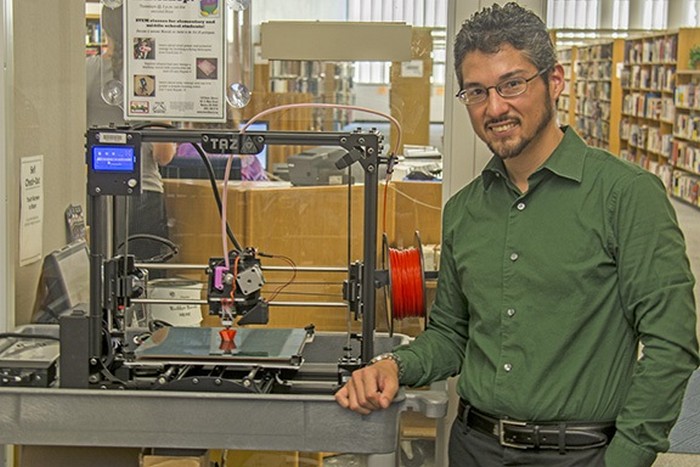 Article and photo by Richard Lieberman
Article and photo by Richard Lieberman
The spotlight is on 3-D printing, a technology that has been emerging since engineers in the 1980’s produced working models, and since then the printers have undergone refinements and technological improvements that have brought the devices to the general public. Schools are getting 3-D printers, Small businesses are putting the devices to work, Libraries have discovered 3-D printers, there are even 3-D printer models designed for home use at affordable prices.
Ron Solorzano, Library Technician I at the E.P Foster Library, 651 E. Main Street, Ventura, has embraced the technology with a fervor that began nearly 2 years ago when the Library acquired its first 3-D printers. One of Mr. Solórzano’s goals is to introduce 3-D printing to schools, and school age children “it’s moving so fast, and the technology is getting better” said Solorzano. Solórzano added “We are giving the tools the community needs to effectively use, and embrace this technology.”
The library is offering workshops, every Wednesday to acquaint the public with 3-D printing techniques, use of the software needed, and the tools to accomplish 3-D modeling. The public is also welcome to find and share the modeling work of others. There are several websites for 3-D modelers that share work already done. Many of the models can be downloaded and brought to the library and printed.
3-D printing has enormous potential, and has been used to create things as small as a human cell and as large as a bridge.
The first steps in creating a 3-D image is to create an image of the item the user is attempting to create using various software suites. After designing and creating the image it is then sent to the printer. Production begins with a platform where the model will be built. The printer then lays down a very thin layer of material. The library lab is using PLA Filament as the basic material, and offers it to the public at 10 cents per gram. Then the printer lays down layer after layer, until the designed item is built, building from the ground up.
The printers and the process is popular among manufacturers, and production facilities giving the facilities a solid 3-D prototype to examine. This process gives an advantage to many manufacturers by allowing the manufacturer to skip the costly, and intensive process of casting aluminum or other metals to create tooling. The 3-D printing process gives a manufacturer the opportunity to efficiently and inexpensively create castings and skip the long-term casting process.
Fully functional items are rarely produced. Items are made with many pieces that need to be assembled after coming off the printers. Some people believe that 3-D printers will ultimately change the way the world does business. Some believe that manufacturing will no longer be the province of large corporations with elaborate factories. Instead they will be replaced by rows of functioning 3-D printers printing anything from buttons to chocolate concoctions already being used by the Hershey Corporation.
Currently Solórzano has been promoted and will be leaving the E.P. Foster library to join the main library in Ojai. “We are currently cross training 4 staff members to take over the 3-D printer operations .” Added Solórzano.
An opportunity to try your hand at designing and using 3-D printing is available at the library. Call the library for the training schedule and to enroll in one of the offered classes (805) 648-3696.

